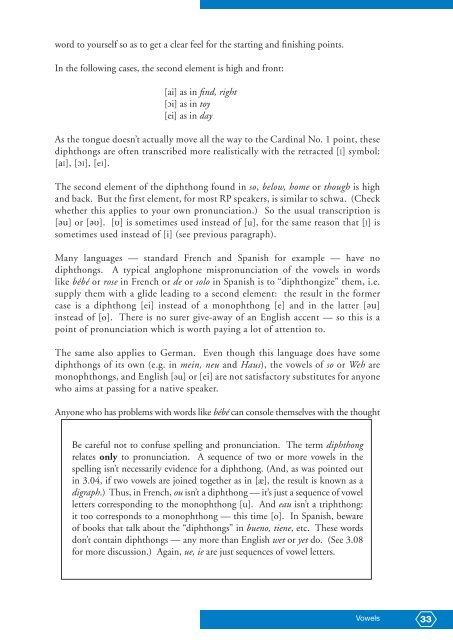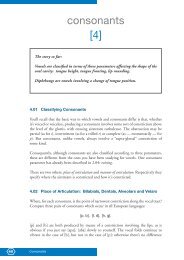PHONETICS MANUAL.indd - HumBox
PHONETICS MANUAL.indd - HumBox
PHONETICS MANUAL.indd - HumBox
Create successful ePaper yourself
Turn your PDF publications into a flip-book with our unique Google optimized e-Paper software.
word to yourself so as to get a clear feel for the starting and finishing points.<br />
In the following cases, the second element is high and front:<br />
[ai] as in find, right<br />
[Oi] as in toy<br />
[ei] as in day<br />
As the tongue doesn’t actually move all the way to the Cardinal No. 1 point, these<br />
diphthongs are often transcribed more realistically with the retracted [I] symbol:<br />
[aI], [OI], [eI].<br />
The second element of the diphthong found in so, below, home or though is high<br />
and back. But the first element, for most RP speakers, is similar to schwa. (Check<br />
whether this applies to your own pronunciation.) So the usual transcription is<br />
[@u] or [@U]. [U] is sometimes used instead of [u], for the same reason that [I] is<br />
sometimes used instead of [i] (see previous paragraph).<br />
Many languages — standard French and Spanish for example — have no<br />
diphthongs. A typical anglophone mispronunciation of the vowels in words<br />
like bébé or rose in French or de or solo in Spanish is to “diphthongize” them, i.e.<br />
supply them with a glide leading to a second element: the result in the former<br />
case is a diphthong [ei] instead of a monophthong [e] and in the latter [@u]<br />
instead of [o]. There is no surer give-away of an English accent — so this is a<br />
point of pronunciation which is worth paying a lot of attention to.<br />
The same also applies to German. Even though this language does have some<br />
diphthongs of its own (e.g. in mein, neu and Haus), the vowels of so or Weh are<br />
monophthongs, and English [@u] or [ei] are not satisfactory substitutes for anyone<br />
who aims at passing for a native speaker.<br />
Anyone who has problems with words like bébé can console themselves with the thought<br />
Be careful not to confuse spelling and pronunciation. The term diphthong<br />
relates only to pronunciation. A sequence of two or more vowels in the<br />
spelling isn’t necessarily evidence for a diphthong. (And, as was pointed out<br />
in 3.04, if two vowels are joined together as in [æ], the result is known as a<br />
digraph.) Thus, in French, ou isn’t a diphthong — it’s just a sequence of vowel<br />
letters corresponding to the monophthong [u]. And eau isn’t a triphthong:<br />
it too corresponds to a monophthong — this time [o]. In Spanish, beware<br />
of books that talk about the “diphthongs” in bueno, tiene, etc. These words<br />
don’t contain diphthongs — any more than English wet or yet do. (See 3.08<br />
for more discussion.) Again, ue, ie are just sequences of vowel letters.<br />
Vowels<br />
33






